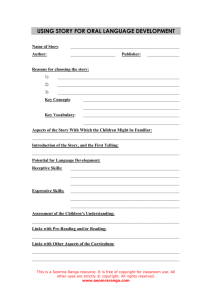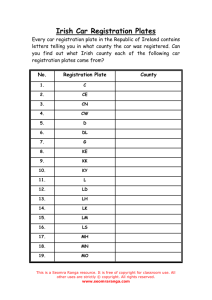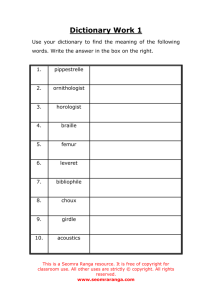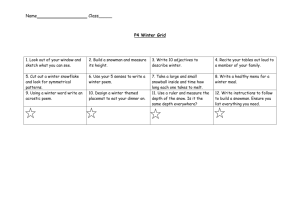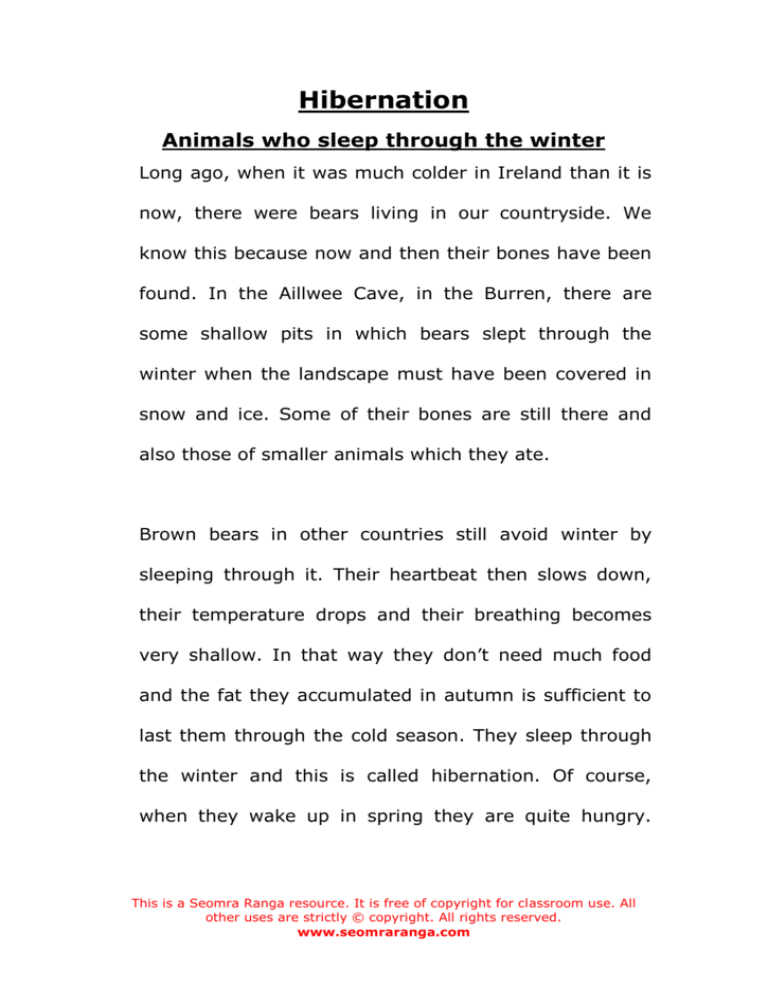
Hibernation
Animals who sleep through the winter
Long ago, when it was much colder in Ireland than it is
now, there were bears living in our countryside. We
know this because now and then their bones have been
found. In the Aillwee Cave, in the Burren, there are
some shallow pits in which bears slept through the
winter when the landscape must have been covered in
snow and ice. Some of their bones are still there and
also those of smaller animals which they ate.
Brown bears in other countries still avoid winter by
sleeping through it. Their heartbeat then slows down,
their temperature drops and their breathing becomes
very shallow. In that way they don’t need much food
and the fat they accumulated in autumn is sufficient to
last them through the cold season. They sleep through
the winter and this is called hibernation. Of course,
when they wake up in spring they are quite hungry.
This is a Seomra Ranga resource. It is free of copyright for classroom use. All
other uses are strictly © copyright. All rights reserved.
www.seomraranga.com
Hibernation is an energy-saving invention, sparing
bears a lot of hardship.
Strangely enough, polar bears, which live in a much
colder climate, do not hibernate at all but stay active
through the arctic winter. They live on seals, though,
and don’t dig for roots, and as they have very thick
coats and they are not afraid of the cold either.
Bats
In Ireland few animals go into
complete hibernation but one
that does is the bat. Bats have
to do this because they are
small
and
lose
heat
very
quickly. In winter they would have to eat much more
than they do in summer. That would be fine if they ate
nuts or roots but bats live on flying insects and there
are not many of those about in December and January.
This is a Seomra Ranga resource. It is free of copyright for classroom use. All
other uses are strictly © copyright. All rights reserved.
www.seomraranga.com
So bats hibernate in some sheltered spot, a cave or an
attic or a hollow tree, close together to preserve heat,
with their wings folded around them. Not moving, their
body temperature drops sharply, their tiny hearts beat
very slowly, and so they preserve precious energy.
They do need an even temperature, between 2 and 6
degrees Celsius. If it gets warmer, they’ll wake up and
find a cooler spot but when there is the danger of sharp
frost, they also wake up and try to find a somewhat
warmer place.
Hedgehogs
Hedgehogs
hibernators.
are
They
well
known
choose
a
sheltered spot, in a ditch or under
a pile of branches or wood and
make a weatherproof winter nest out of dry leaves, held
together by brambles and twigs. Rolled up inside, the
animal snores away, not eating but surviving on a layer
This is a Seomra Ranga resource. It is free of copyright for classroom use. All
other uses are strictly © copyright. All rights reserved.
www.seomraranga.com
of fat. However, during warm spells, it might wake up
and go for a ramble, and find some juicy hibernating
snails or beetles, like a child sneaking down during the
night to raid the fridge.
Badgers
Badgers do not hibernate but they
sleep a lot. They come out of their
setts to forage when it is dark.
During the long winter nights they have plenty of
opportunity to go digging for worms and beetles and
root for the bulbs of bluebells, which they like very
much. All the same, badgers sleep a lot as well during
winter but not in the same way bats and hedgehogs do
– a badger’s temperature and heartbeat stay the same
all year round.
This is a Seomra Ranga resource. It is free of copyright for classroom use. All
other uses are strictly © copyright. All rights reserved.
www.seomraranga.com
Otters
For fish-eating animals such as
otters, there is, of course, no
need
at
all
to
sleep
through
winter. Their food is always there, even if it is under
ice.
Foxes
Foxes
don’t
hibernate
either,
though some may have a hard
time during winter, when there are few young rabbits,
mice and rats are hidden. Hibernation is one of the
ways for animals to escape the winter, when there is
little food and it is so cold. They stay asleep to preserve
precious energy. Wouldn’t it be handy if we could do
the same!
This is a Seomra Ranga resource. It is free of copyright for classroom use. All
other uses are strictly © copyright. All rights reserved.
www.seomraranga.com
Insects
Many insects also hibernate. In
winter there are no flowers to
feed
on,
so
tortoiseshells
and
other butterflies try to find a frost-free but cool spot to
sleep through winter. They often come into houses and
sheds, sometimes in large numbers to hibernate in
hidden corners. If the room then is heated, they wake
up and start fluttering about. That may prove fatal, as
they are spending energy and may starve during the
rest of the winter. So, if you disturb hibernating
butterflies at home, a kind thing to do is to put them in
a different, unheated but frost-free spot, in a dark
corner, so that they may sleep on and wake up in
spring.
Frogs
Frogs spend the winter at the
bottom of ponds and other still
This is a Seomra Ranga resource. It is free of copyright for classroom use. All
other uses are strictly © copyright. All rights reserved.
www.seomraranga.com
water, deep down in the mud. They can’t stand being
frozen but don’t mind very much and will wake up in
very early spring ready to find a pond or ditch and fill it
with frogspawn.
Squirrels
Squirrels in Ireland do not truly
hibernate. They will sleep a lot
though, warm and cosy in their
nest, called dreys, against the trunk of a tree. Red
squirrels eat a lot of pine seeds and after a good year
they will have accumulated sufficient fat reserve to last
the winter. Then there is little need to wake up and go
to try and find a snack. But if food has been scarce,
many squirrels don’t last until spring. Grey squirrels
have the advantage that they can digest acorns which
red squirrels do not eat and so they have a better
chance to survive a cold winter. It is one of the reasons
they are so successful and are now becoming more
common here than red squirrels.
This is a Seomra Ranga resource. It is free of copyright for classroom use. All
other uses are strictly © copyright. All rights reserved.
www.seomraranga.com
Birds
Birds, of course, don’t hibernate.
They have different ways to avoid
shortage of suitable food. They
migrate. Swallows wouldn’t find enough flies here in
December, so they go to countries down south where
there are plenty, and so do many more insect-eating
birds. In our turn, we play host to millions of birds from
colder countries like Siberia, Scandinavia, Iceland and
Greenland, where in winter there is hardly anything to
eat at all. At the end of summer Ireland fills up with
waders, duck, geese and swans, that wouldn’t survive
staying at home in the cold north.
by Gerrit Van Gelderen (taken from a newspaper article
published sometime in the 1990’s)
This is a Seomra Ranga resource. It is free of copyright for classroom use. All
other uses are strictly © copyright. All rights reserved.
www.seomraranga.com

